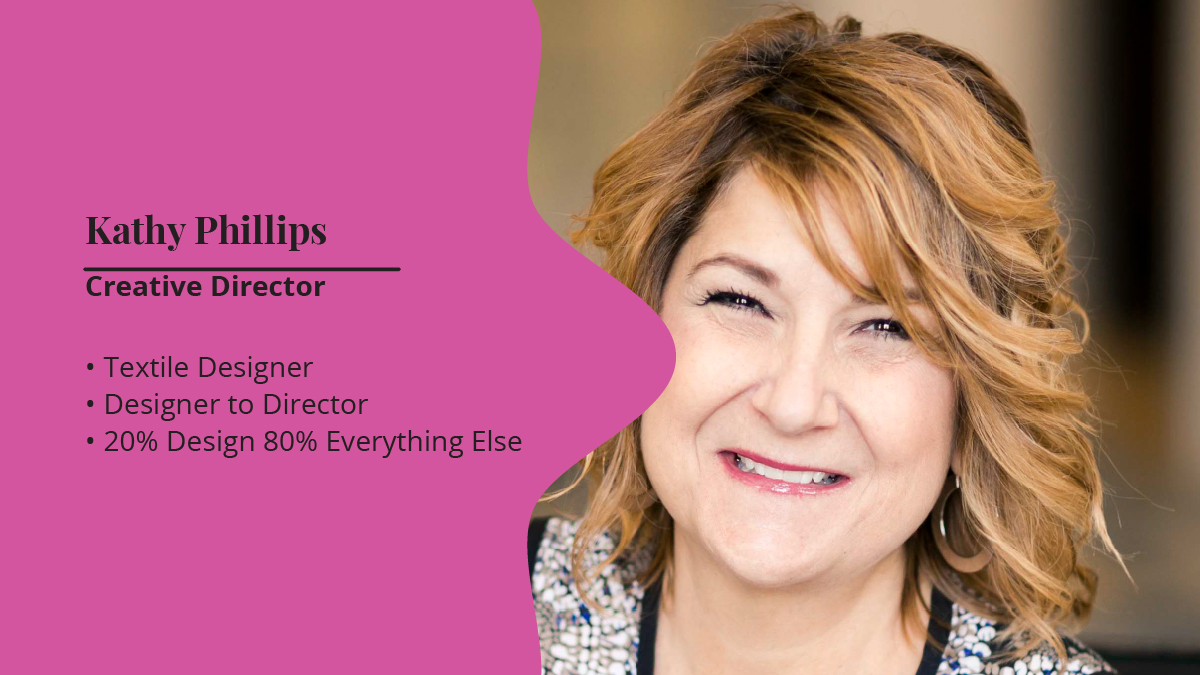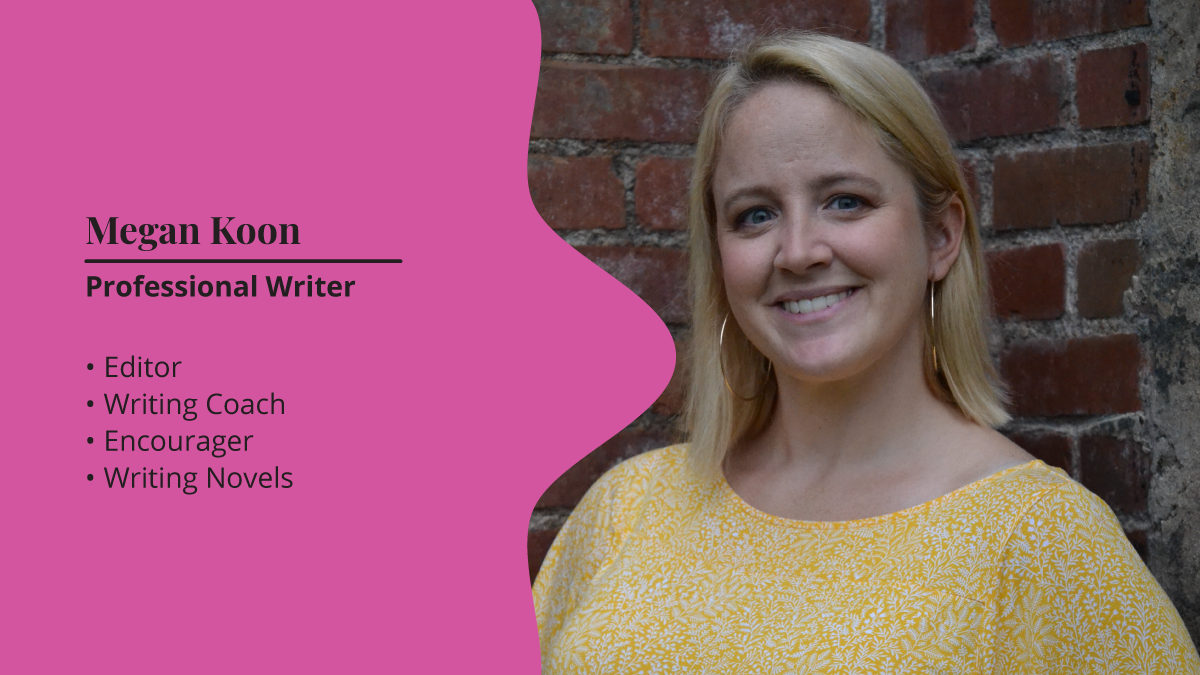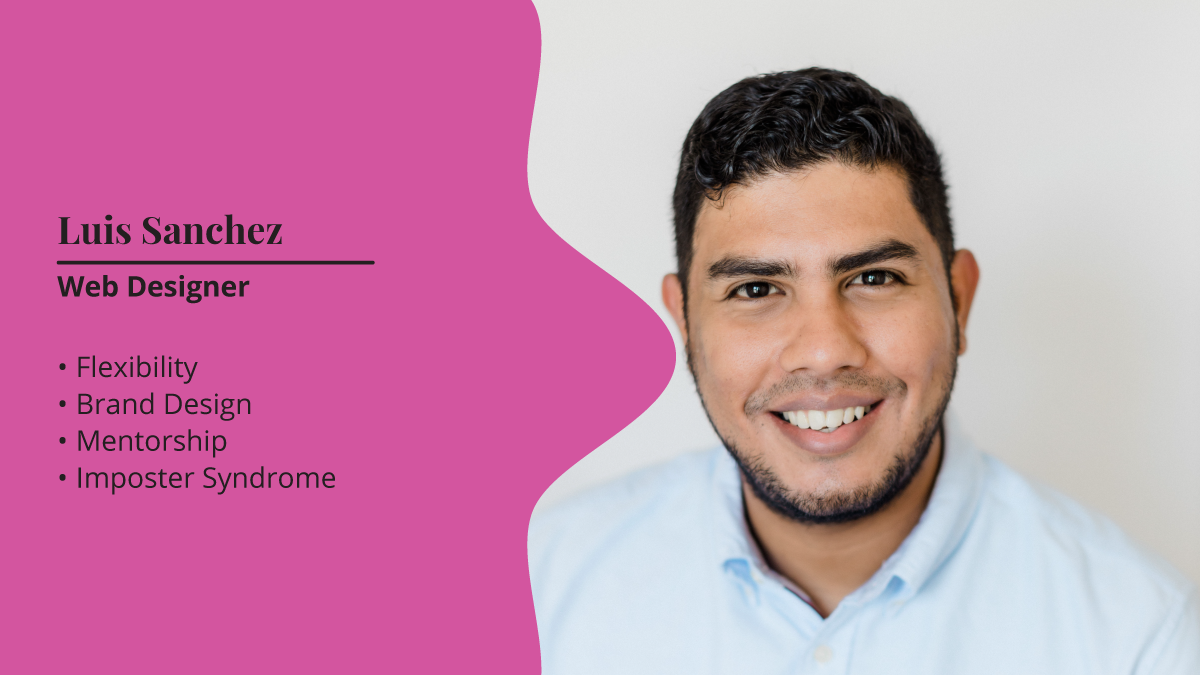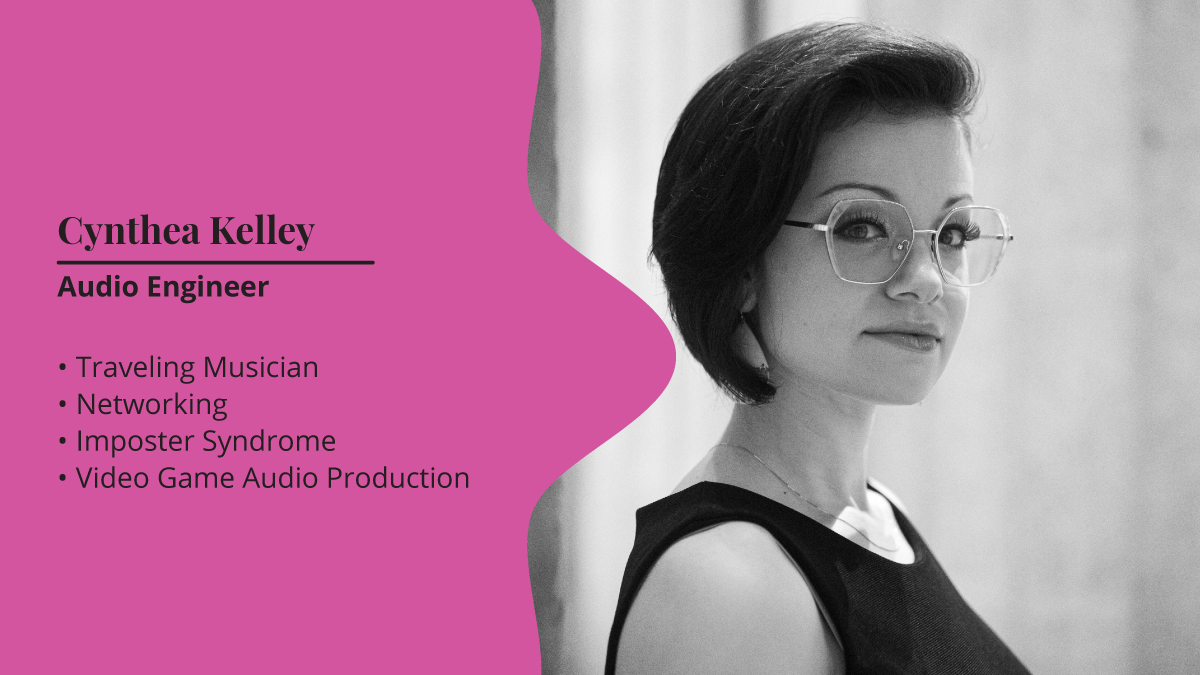“Just follow your path and there are some great opportunities out there for an artist.”
Kathy Phillips is the Creative Director for Springs Creatives and the Chief Curator at Baxter Mill Archive. She holds a degree in Costume Design in Theater and a Masters in Costume Designing.
Interview
Transcript
Kathy Phillips
Hi, I’m Kathy Phillips. I’m originally from Pittsburgh, Pennsylvania. But I’ve been down in South Carolina since 1998. So I am now living in what’s called Indian land, which is like 20 miles south of Charlotte.
Emma Plutnicki
Perfect. So what do you do for work? What’s your official job title?
Kathy Phillips
So I was thinking about that because I figured I got a couple of jobs going on right now; as you know, in the career field, I think nowadays you, you end up having more than one job title. So I’m actually I’m a chief creator. Well, I’m a creative director for the retail side of Springs because we only manufacture fabric for like the big retail shops, of like, JoAnn Fabric, Walmart, and Hobby Lobby. And then I’m also the Chief Curator over Baxter Mill Archive. So, I look over and I can tell you what that’s all about as well. But that’s pretty much you could say Creative Director slash Chief Curator. And then anything else?
Emma Plutnicki
Yeah, amazing. So how long have you been doing that or something like that?
Kathy Phillips
So, I moved down here, 98. So I would say I’ve been, you know, I started off as a textile designer here in South Carolina working for the Springs family, which is one of the largest manufacturing, like I said, the textile industry, creating textiles for the home industry. So I would say like for I would design for shower curtains, towels, rugs, tops of beds, bedding, pillows, everything you name it, we created. And then I guess I left for like four years because I went in…when China when everything went over to China, I had left and went to work for a Chinese company and worked with them for four years. And I was designing textiles there. And I was a creative director for them. JLA home. And so I did that for about four years. And then I begged my… for my job back because working for a Chinese company was really rough. And so then I came back here. And so now I’m working with springs doing the same thing, textile design, and a little bit of everything, but kind of I am done. I mean, I still do textile design. But I do that now on my side, but I’m more of a director now. What, like giving everybody direction on how to start for the product.
Emma Plutnicki
Yeah, amazing. So how did you end up in this field? How did you know that it was a field that you could go into what kind of led you Yeah,
Kathy Phillips
Yeah, so it’s funny because as a, you know, it’s funny because I, I was born in a creative family. So, my mother, my mother was, I guess, what you would call now a maker like creative. Like, think of her as like she was Martha Stewart in her time. So she always encouraged me with my artistic ability to kind of pursue something artistically. And, I had a brother who was he’s an architect, my other brothers are fine artists, and my sister’s an interior designer. So we’re all, and my father’s a chef. So, we’re all kind of very creative, but I love to sew. So I’ve been sewing all my life. And I took all these sewing classes, you know, back in the day when they had Home Ec [Home Economics], and so and I love fashion, so I was gonna get into fashion design. And when I went to school, I felt like I didn’t fit into fashion design students. And I wanted something a little bit different. And I found out about costume design and theater.
Kathy Phillips
So, I actually majored in costume design. And I have a Master’s in Costume Design. And so, I worked in Connecticut for about 10 years in that field of designing costumes for, like, Off-Off-Broadway and stage theater in Hartford Stage Company. And so, I worked in that field, and I loved it, absolutely loved it. And then Casual Corner, which is a fashion company, found me, and they said, it was a job opening for textile design, which I didn’t even know what that was. But what they did was they said, this is your this is a computer; it’s a Wacom tablet, and we’re going to show you how to do textile design on a computer. Because, before that, we were called board artists; we would literally paint and everything textile design. So that’s how I kind of got into textile design. I also did sweater design with them. I think that’s what’s really interesting. I felt like, you know, as a designer, as an artist, once you know that you’re good at it, I guess you can design anything as long as you know what the parameters are, you know, and say okay, this is a sweater, you have to, you know, this is how you have to design for a sweater, this is how you have to design for a shower curtain, you know, certain scales and for a window. And once you know all the, you know, the, I guess the the rules, you know, you can basically design anything but for textile design. I didn’t even know this existed. And it’s funny because a lot of students today I’ll have come in here, a lot of college students, even high school students, they’re artists, they want to be artists, designers, and they didn’t even know textile even existed or surface design. So, they don’t really teach it or you don’t learn a lot about it. And so people just fall into it.
Kathy Phillips
And so a lot of my interns ended up taking this career because I hired a girl who was an illustrator for, you know, who studied to be an illustrator. And then I taught her, you know, the rules of textile design, and now she’s been hired here and she’s been doing textile design. And one of my graphic designers he actually does sign designs. He was craving designs for, you know, large signs for corporations, and I was looking for somebody who knew illustrator really well. And so now he is my designer for, like, Marvel, we have those licenses. So we have Marvel, Disney, Nintendo, you name it, we, we, so we design fabrics for that. So again, I taught Nate the rules of learning textile design in Illustrator. And you know, this is Disney, this is what they need. He was able to now, now he’s a textile designer, you know, so, a lot of people were surprised, like, I didn’t even know this existed, so.
Emma Plutnicki
Yeah, that’s cool. So, nowadays, what is your typical day look like? Are you more managing or what? What is the typical…
Kathy Phillips
Every day’s a different day, every… and that’s what I love about it. It’s not so corporate, you know, I’m still in the corporate world. But every single day is different. Actually, the Baxter network, I’ve opened Chief Curator with that it’s over probably 1 million pieces of antique archives of like from all over the world. And we use it as a library, we invite designers, retailers, like, anthropology will come in here and posting things for their art and for their line, you know, whether it’s apparel or home. It’s like kind of just a really big inspiration library. And we’re in the move. We’re in the middle of a move across the street. And so, I’ve been packing, I’ve been organizing, that’s like that part I’m also working with I don’t know if you guys know Fashion Snoops. It’s a trend forecasting company. And so they’ll give me all the trends that they’re working on. And I’ll go into the archives, and I’ll pull things for them for the Trend Report. So I’ve been working on that, like for the last three days in that. And then, on the other side of retail, we have big Hobby Lobby meetings. So, working with the designers there, making sure you know the designs look good and printing out everything that we’re going to present to the Hobby Lobby customers. So yeah, it’s different every day, which I love. Yeah.
Emma Plutnicki
Keeps it exciting.
Kathy Phillips
Yeah, so.
Emma Plutnicki
So, throughout your career, have you had a specific moment or project that you’ve created that kind of resonated with you or had a significant impact on your life? Maybe it’s a design. Maybe it’s a project.
Kathy Phillips
Oh, a little bit of everything. So there’s, it’s called the Spring Lake. It’s a brand that Springs owns. And the challenge was how to revamp it because it was like 1940’s was kind of old, you know, and they wanted to kind of revamp it and rebrand it and make it something special. So, I was on a team of three other people. So, I was the creative director. We had a salesperson, a marketing and merchandising. And the four of us came up with what the plan was to do this. And it was fun because I got to go and photograph all the designs. So, I was overall about designs, and it ended up in Target, and it was just like literally a 24-foot modular, so it was kind of neat, taking my family, my kids and go, Mom did this, you know, and so that was really neat. And it ended up being in Target all, all doors of targets, so it landed there. So that was that was pretty cool.
Kathy Phillips
And then I guess what ended up happening, was this was all designed down in South Carolina. And then they want to move the brand to New York, they were moving everything to New York, because you New York designs better than anybody else or something. But anyway, so when that happened, Target said, what happened, this doesn’t look like what it was because they hired all new people. And, and then, it just didn’t go anywhere after that. But so, launching that that Springmade brand was it was pretty cool. I really enjoyed that. And I think like my other things are, so I do my own fiber art. So I designed like art quilts, but they’re so like a cow, for instance. And I’ll paint it and then a thread painted on the on the sewing machine. And when I did that, I actually I entered it in a contest; I won first place in the quilt show. So, that was pretty cool. So you know things like that. Modes of accomplishments. But that’s just something I like to do on the side. When I get home at night. I still create and do my own stuff.
Emma Plutnicki
Yeah, that’s awesome. I love that. And so, you said you moved to South Carolina in 1998. Right? So, when you first came, how did you kind of get into the scene? Were there any like events that you went to or organizations that you joined to network and kind of build yourself in the area or anything that you know of today?
Kathy Phillips
Yeah, well, you know, today, it’s so different in ’98 compared to now because now there’s so much more social media, there’s a lot of things that you can follow and listen to a lot of podcasts and things like that. Back then. I think I was more driven by my career. So I kind of like I just worked a lot like that. That was your way into getting to know people. We traveled to a lot of shows I would go to New York and set up showrooms, and so I think it was just knowing other people in the business, you know, and I only have I had a two-year-old child then, so it wasn’t really I wasn’t able to really get out into the scene. But nowadays, what I do, I definitely I follow a lot of things on Instagram I follow. I listened to a lot of podcasts and read a lot of books. And kind of just like I like to say I find my tribe. Uh, you know, I like to look for my tribe and kind of, like, follow groups that are, I mean, at the fiber arts group, and I’m going to knit Quilt Guild a couple of those. And I go to those now all the time and things like that. And I’m always taking classes I still, I just feel like you never stopped learning. I recently… there’s a fiber arts class in Stuart, Florida, Aya Fibers Art Studio. And I’ve tried to take one of those once a year, and I learned Shibori dyeing, I’ve learned ego pruning, I’ve learned surface design, and it just I’m always trying to, like improve my skills. Even at this stage, I just love doing it, you know,
Emma Plutnicki
Oh, that’s perfect. So, along with continuing to educate yourself and learn new skills. Is there any other skills that you think that you have that really help you in your job? Maybe it’s like organization or creativity, any, like specific skills that help?
Kathy Phillips
Yeah, creativity is number one, I think everybody’s creative. I think, also organization-like; it’s funny because I remember my professor back in grad school, and I didn’t get it then. And I kind of was mad when she said; she had this little accent, she would be she’s Argentina, she goes, Kathy 80%- 20% is design. 80% is everything else. And I’m like, what, you know, I want 100% design. But, when you get into corporate and when you start going out there and making your own career, I realized she was so right, because like 20% is really designed. 80% is the marketing. It’s organization; it’s just the communication; there’s so much more, and really, 20% is designed.
Kathy Phillips
And then I was listening to podcasts, and they were saying that you know, when you look on online, or like when you look at Instagram, or you see these artists who really, really are not good, but they’re so well known, like how they, how they get there, and when you have a really good artist, but they’re not well-known something like that, but it’s really marketing, and like if if you have good marketing skills, and you want to become a designer, you want to become an artist, you have to know how to sell yourself. So, I think, and I love marketing, you know, and so I think marketing is a really good skill to have. And I encourage like, students who are artists that take a marketing course because I think that’s like that’s very important for anyone to know because now I have to market. You know, I have to sell our product to different designers in this Backstream archive, I’m in the middle of trying to market it, and trying to find my customers. And so, I’m trying to figure out unique ways to do Instagram and social media. I’m starting to write blogs, you know, and Chapt GPT is my best friend. Yeah, love that person.
Emma Plutnicki
Amazing. So, just as we wrap up, along with marketing yourself and learning that background, is there any other advice that you can recommend to people who are trying to break into a field like yours?
Kathy Phillips
Yeah, I feel like it, whether it’s this field or any kind of creative or artistic field, I feel, you know, going through the years, I always hear people’s stories about always, like I would do. I always liked I would go to high school, and they would let me speak in front of the art students. And I said that I’m here to say that you can make a living being an artist and, and successful and I guess some people think success is being famous, or how many likes and all that kind of stuff. But I feel like it’s not really that it’s; I have a really big paycheck, raised a family, and my son’s graduated from Vet school. I mean, I make good money, being through the career that I have as being an artist, and I feel that you can be an artist; you have to work very hard at it and be passionate about it. But if you’re very passionate, you’re driven.
Kathy Phillips
I just feel like, like, there’s so many paths of being an artist or designer in the creative field that you do your research and look, you know, especially nowadays, you can look online and read good books, and I have a good book art that we are by Marian showmen. It’s about making your life as an artist, you know, making a living and making a good career, and I just feel like, you know, you just follow your path, and there’s some, there’s good opportunity out there for creative and artistic people. And it’s not just art, you know, you can be a shoe designer, you can surface designer, you can create art that’s on any surface, you know, whether it’s like calendars and in, I don’t know, like like paper goods and wrapping paper. And that’s all surface design, like anything that has a pattern on it was created by somebody and if you want that field, then I would say definitely no Photoshop and Illustrator and know how to create a repeat, you know, pattern. That’s probably your top thing. You know, you just have a really good portfolio to show to customers.
Emma Plutnicki
And I think, one of the really good things to tell somebody is I would be persistent when you if you’re really interested in a company that you want to work for and you kind of send them your resume. You send them your resume, and you talk to them or whatever. Follow up. Be a pain in the butt. Because I, you know, as a creative director, I get so busy, and I’ll forget about somebody, and then all of a sudden they’ll send me an email and then I might have a project going oh, again, well, hey, are you available right now? Can I use you right now? Like it is about being persistent in front of that person as much as you might think you’re being a pain. I think I love seeing somebody be persistent, because then that tells me that they’re passionate about what they want. I had one girl who she couldn’t get a hold of me in my email. So, she just showed up. I mean, she just showed up in my office. And I was like, someone says, so, and so is here, and I’m like, I don’t even know who this girl is, and she goes, I was trying to get in touch with you. And I really love to work here. Do you have any kind of internship or something like that? And I was like, oh my god, I’m so impressed that you just showed up, you know? And so anyway, so she comes in every like, it’s now she’s, she’s at SCAD [Savannah College of Art and Design. And now, she’ll come on Christmas break and things like that. And help in turn, you know, so? Yeah.
Kathy Phillips
Yeah, yeah, yeah, and don’t compare yourself to anybody. Just be you. That’s that’s one thing. I think with social media because I do it. I look. Oh, that person is so good. Like, I’ll never be like that. And like, that’s the only downfall I think of social media is like you got to just like I tell my kids, you be you. You be you, and that’s all you should worry about. Not worry about whatever anybody else thinks; you just got to do you and find you. So yeah.
Emma Plutnicki
For sure. That’s great advice. So thank you so much.



